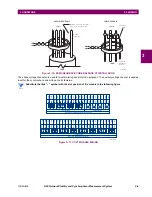
GE Multilin
N60 Network Stability and Synchrophasor Measurement System
3-7
3 HARDWARE
3.2 WIRING
3
3.2.2 DIELECTRIC STRENGTH
The dielectric strength of the UR-series module hardware is shown in the following table:
Filter networks and transient protection clamps are used in the hardware to prevent damage caused by high peak voltage
transients, radio frequency interference (RFI), and electromagnetic interference (EMI). These protective components
can
be damaged
by application of the ANSI/IEEE C37.90 specified test voltage for a period longer than the specified one min-
ute.
3.2.3 CONTROL POWER
CONTROL POWER SUPPLIED TO THE RELAY MUST BE CONNECTED TO THE MATCHING POWER SUPPLY
RANGE OF THE RELAY. IF THE VOLTAGE IS APPLIED TO THE WRONG TERMINALS, DAMAGE MAY
OCCUR!
The N60 relay, like almost all electronic relays, contains electrolytic capacitors. These capacitors are well
known to be subject to deterioration over time if voltage is not applied periodically. Deterioration can be
avoided by powering the relays up once a year.
The power supply module can be ordered for two possible voltage ranges, with or without a redundant power option. Each
range has a dedicated input connection for proper operation. The ranges are as shown below (see the
Technical specifica-
tions
section of chapter 2 for additional details):
•
Low (LO) range: 24 to 48 V (DC only) nominal.
•
High (HI) range: 125 to 250 V nominal.
The power supply module provides power to the relay and supplies power for dry contact input connections.
The power supply module provides 48 V DC power for dry contact input connections and a critical failure relay (see the
Typical wiring diagram
earlier). The critical failure relay is a form-C device that will be energized once control power is
applied and the relay has successfully booted up with no critical self-test failures. If on-going self-test diagnostic checks
detect a critical failure (see the
Self-test errors
section in chapter 7) or control power is lost, the relay will de-energize.
For high reliability systems, the N60 has a redundant option in which two N60 power supplies are placed in parallel on the
bus. If one of the power supplies become faulted, the second power supply will assume the full load of the relay without any
interruptions. Each power supply has a green LED on the front of the module to indicate it is functional. The critical fail relay
of the module will also indicate a faulted power supply.
Table 3–1: DIELECTRIC STRENGTH OF UR-SERIES MODULE HARDWARE
MODULE
TYPE
MODULE FUNCTION
TERMINALS
DIELECTRIC STRENGTH
(AC)
FROM
TO
1
Power supply
High (+); Low (+); (–)
Chassis
2000 V AC for 1 minute
1
Power supply
48 V DC (+) and (–)
Chassis
2000 V AC for 1 minute
1
Power supply
Relay terminals
Chassis
2000 V AC for 1 minute
2
Reserved
N/A
N/A
N/A
3
Reserved
N/A
N/A
N/A
4
Reserved
N/A
N/A
N/A
5
Analog inputs/outputs
All except 8b
Chassis
< 50 V DC
6
Digital inputs/outputs
All
Chassis
2000 V AC for 1 minute
7
G.703
All except 2b, 3a, 7b, 8a
Chassis
2000 V AC for 1 minute
RS422
All except 6a, 7b, 8a
Chassis
< 50 V DC
8
CT/VT
All
Chassis
2000 V AC for 1 minute
9
CPU
All
Chassis
2000 V AC for 1 minute
CAUTION
NOTE






































